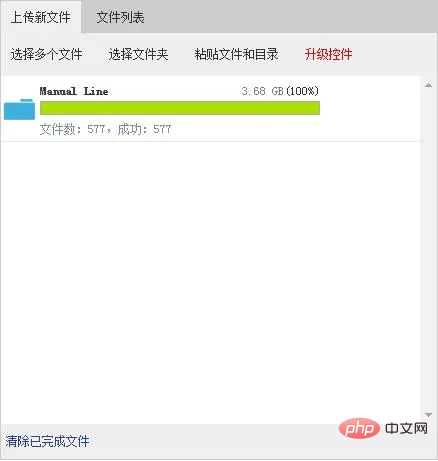How to implement multi-part file upload in PHP
Jan 17, 2020 pm 05:35 PM
PHP uses the super global variable array $_FILES to record file upload related information.
1.file_uploads=on/off
Whether it is allowed to upload files via http
2.max_execution_time=30
The maximum script execution time is allowed. If this time is exceeded, an error will be reported.
3.memory_limit=50M
Set the script to be allocated The maximum amount of memory to prevent runaway scripts from occupying too much memory. This directive can only be set at compile time.
--It only takes effect when the enable-memory-limit flag is set
4.upload_max_filesize=20M
The maximum size of files allowed to be uploaded, this The command must be smaller than post_max_size
5.upload_tmp_dir
Temporary storage directory for uploaded files
6.post_max_size=30M
Allow the post mode to accept the maximum size
$_FILES['myFile']['name'] The original name of the client's last file.
$_FILES['myFile']['type'] The MIME type of the file, which requires the browser to provide support for this information, such as "image/gif".
$_FILES['myFile']['size'] The size of the uploaded file, in bytes.
$_FILES['myFile']['tmp_name'] The temporary file name stored on the server after the file is uploaded, usually the system default. It can be specified in upload_tmp_dir in php.ini, but setting it with the putenv() function has no effect.
$_FILES['myFile']['error'] Status code related to the file upload. ['error'] was added in PHP 4.2.0. The following is its description: (They became constants after PHP3.0)
UPLOAD_ERR_OK
Value: 0; No error occurred and the file was uploaded successfully.
UPLOAD_ERR_INI_SIZE
Value: 1; The uploaded file exceeds the value limited by the upload_max_filesize option in php.ini.
UPLOAD_ERR_FORM_SIZE
Value: 2; The size of the uploaded file exceeds the value specified by the MAX_FILE_SIZE option in the HTML form.
UPLOAD_ERR_PARTIAL
Value: 3; Only part of the file was uploaded.
UPLOAD_ERR_NO_FILE
Value: 4; No file was uploaded.
Value: 5; The uploaded file size is 0.
After the file is uploaded, it is stored in the temporary directory by default. At this time, you must delete it from the temporary directory or Move it somewhere else, or if it doesn't exist, it will be deleted.
That is, regardless of whether the upload is successful or not, the files in the temporary directory will definitely be deleted after the script is executed.
Attachment: How to modify the size limit of PHP upload files
1. General file upload, unless the file is very small. Like a 5M file, it will probably take more than a minute to upload.
But in php, the default maximum execution time of the page is 30 seconds. That is to say, if it exceeds 30 seconds, the script will stop executing.
This results in the failure to open For the situation of the web page, we can modify max_execution_time
Look for
max_execution_time
in php.ini. The default is 30 seconds. Change to
max_execution_time = 0
0 means no limit
2. Modify post_max_size to set the maximum size allowed for POST data. This setting also affects file uploads.
The default post_max_size of php is 2M. If the POST data size is larger than post_max_size, $_POST and $_FILES superglobals will be empty.
Find post_max_size. Change to
post_max_size = 150M
3. Many people will change the second step, but the maximum size when uploading files is still 8M.
Why? We also need to change a parameter upload_max_filesize to indicate the maximum size of the uploaded file.
Look for upload_max_filesize, the default is 8M and change it to
upload_max_filesize = 100M
In addition, it should be noted that post_max_size is better than upload_max_filesize.
Upload effect display :

PHP Chinese website has a large number of free PHP video tutorials, everyone is welcome to learn!
This article is reproduced from: https://www.jianshu.com/p/6460dc947209

Hot AI Tools

Undress AI Tool
Undress images for free

Undresser.AI Undress
AI-powered app for creating realistic nude photos

AI Clothes Remover
Online AI tool for removing clothes from photos.

Clothoff.io
AI clothes remover

Video Face Swap
Swap faces in any video effortlessly with our completely free AI face swap tool!

Hot Article

Hot Tools

Notepad++7.3.1
Easy-to-use and free code editor

SublimeText3 Chinese version
Chinese version, very easy to use

Zend Studio 13.0.1
Powerful PHP integrated development environment

Dreamweaver CS6
Visual web development tools

SublimeText3 Mac version
God-level code editing software (SublimeText3)

Hot Topics
 How Do Generators Work in PHP?
Jul 11, 2025 am 03:12 AM
How Do Generators Work in PHP?
Jul 11, 2025 am 03:12 AM
AgeneratorinPHPisamemory-efficientwaytoiterateoverlargedatasetsbyyieldingvaluesoneatatimeinsteadofreturningthemallatonce.1.Generatorsusetheyieldkeywordtoproducevaluesondemand,reducingmemoryusage.2.Theyareusefulforhandlingbigloops,readinglargefiles,or
 How to access a character in a string by index in PHP
Jul 12, 2025 am 03:15 AM
How to access a character in a string by index in PHP
Jul 12, 2025 am 03:15 AM
In PHP, you can use square brackets or curly braces to obtain string specific index characters, but square brackets are recommended; the index starts from 0, and the access outside the range returns a null value and cannot be assigned a value; mb_substr is required to handle multi-byte characters. For example: $str="hello";echo$str[0]; output h; and Chinese characters such as mb_substr($str,1,1) need to obtain the correct result; in actual applications, the length of the string should be checked before looping, dynamic strings need to be verified for validity, and multilingual projects recommend using multi-byte security functions uniformly.
 How to prevent session hijacking in PHP?
Jul 11, 2025 am 03:15 AM
How to prevent session hijacking in PHP?
Jul 11, 2025 am 03:15 AM
To prevent session hijacking in PHP, the following measures need to be taken: 1. Use HTTPS to encrypt the transmission and set session.cookie_secure=1 in php.ini; 2. Set the security cookie attributes, including httponly, secure and samesite; 3. Call session_regenerate_id(true) when the user logs in or permissions change to change to change the SessionID; 4. Limit the Session life cycle, reasonably configure gc_maxlifetime and record the user's activity time; 5. Prohibit exposing the SessionID to the URL, and set session.use_only
 How to URL encode a string in PHP with urlencode
Jul 11, 2025 am 03:22 AM
How to URL encode a string in PHP with urlencode
Jul 11, 2025 am 03:22 AM
The urlencode() function is used to encode strings into URL-safe formats, where non-alphanumeric characters (except -, _, and .) are replaced with a percent sign followed by a two-digit hexadecimal number. For example, spaces are converted to signs, exclamation marks are converted to!, and Chinese characters are converted to their UTF-8 encoding form. When using, only the parameter values ??should be encoded, not the entire URL, to avoid damaging the URL structure. For other parts of the URL, such as path segments, the rawurlencode() function should be used, which converts the space to . When processing array parameters, you can use http_build_query() to automatically encode, or manually call urlencode() on each value to ensure safe transfer of data. just
 PHP get the first N characters of a string
Jul 11, 2025 am 03:17 AM
PHP get the first N characters of a string
Jul 11, 2025 am 03:17 AM
You can use substr() or mb_substr() to get the first N characters in PHP. The specific steps are as follows: 1. Use substr($string,0,N) to intercept the first N characters, which is suitable for ASCII characters and is simple and efficient; 2. When processing multi-byte characters (such as Chinese), mb_substr($string,0,N,'UTF-8'), and ensure that mbstring extension is enabled; 3. If the string contains HTML or whitespace characters, you should first use strip_tags() to remove the tags and trim() to clean the spaces, and then intercept them to ensure the results are clean.
 PHP get the last N characters of a string
Jul 11, 2025 am 03:17 AM
PHP get the last N characters of a string
Jul 11, 2025 am 03:17 AM
There are two main ways to get the last N characters of a string in PHP: 1. Use the substr() function to intercept through the negative starting position, which is suitable for single-byte characters; 2. Use the mb_substr() function to support multilingual and UTF-8 encoding to avoid truncating non-English characters; 3. Optionally determine whether the string length is sufficient to handle boundary situations; 4. It is not recommended to use strrev() substr() combination method because it is not safe and inefficient for multi-byte characters.
 How to set and get session variables in PHP?
Jul 12, 2025 am 03:10 AM
How to set and get session variables in PHP?
Jul 12, 2025 am 03:10 AM
To set and get session variables in PHP, you must first always call session_start() at the top of the script to start the session. 1. When setting session variables, use $_SESSION hyperglobal array to assign values ??to specific keys, such as $_SESSION['username']='john_doe'; it can store strings, numbers, arrays and even objects, but avoid storing too much data to avoid affecting performance. 2. When obtaining session variables, you need to call session_start() first, and then access the $_SESSION array through the key, such as echo$_SESSION['username']; it is recommended to use isset() to check whether the variable exists to avoid errors
 How to prevent SQL injection in PHP
Jul 12, 2025 am 03:02 AM
How to prevent SQL injection in PHP
Jul 12, 2025 am 03:02 AM
Key methods to prevent SQL injection in PHP include: 1. Use preprocessing statements (such as PDO or MySQLi) to separate SQL code and data; 2. Turn off simulated preprocessing mode to ensure true preprocessing; 3. Filter and verify user input, such as using is_numeric() and filter_var(); 4. Avoid directly splicing SQL strings and use parameter binding instead; 5. Turn off error display in the production environment and record error logs. These measures comprehensively prevent the risk of SQL injection from mechanisms and details.





